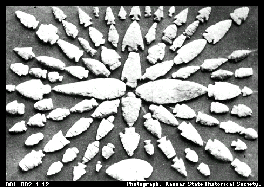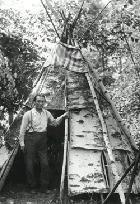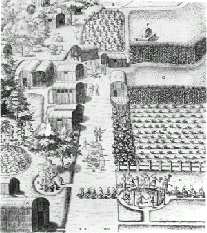American Prehistory: 8000 Years of Forest Management
In the Beginning ...

Figure 1: Map depicting how prehistoric people probably traveled from Asia to North America. Shaded area between Siberia and Alaska was a land bridge. * Map courtesy of American Historical Images On File.
For thousands of years before Columbus set sail for the New World in1492, people lived in the Americas. By crossing a land bridge (exposed because of low sea levels) that connected Siberia with Alaska at the end of the last Ice Age approximately 12,000 years ago, people from Asia followed an ice-free corridor into present day Canada. Termed Native Americans by historians because they were the original inhabitants of North and South America, these early people left evidence both of their existence and customs. Historians and other scholars in related disciplines such as archaeology and anthropology face many challenges when attempting to piece together the mysteries of prehistoric Native American life. Because the first inhabitants of the Americas kept no written records, professionals analyzing this time period must search for clues in order to better understand the lifestyles of the earliest Americans.
Prehistory Vs. History
Historians often divide history into two segments: prehistory and history. Defining prehistory as the period of time in which no written documents existed (history therefore remains the period following prehistory where the written word first appeared), historians are forced to rely upon artifacts, objects made or modified by humans, when examining prehistoric people. Based on artifacts unearthed by archaeologists, historians have divided the history of Native Americans into different time periods. Although not all experts agree on the exact dates for each period, the classification of prehistoric life into distinct ages helps historians emphasize the features shared by cultures at one time and highlight the differences between people of other times.
Paleo
During the first period of prehistory in the Americas, Paleo, estimated to have occurred between 10, 000 and 8,000 B.C., Native Americans were nomads. Living in small groups, the Paleo people moved from place to place following herds of big game such as mammoth and mastodon. The most famous artifact from this period, the Clovis point (named for the original type site near Clovis, New Mexico) was used by Paleoindians to hunt. Found throughout North America, the stone projectile points proved effective in killing both large and small animals. Besides hunting, Native Americans supplemented their diet by gathering fruits, plants, and nuts from nearby forests.
Archaic

Stone points used by prehistoric people to hunt, fish, and fight. The points either were held by hand or mounted onto shafts. * Image courtesy of American Historical Images On File.
The Archaic Period, 8,000-1,000 B.C., had some similarities with the preceding time period. People still relied heavily on hunting for food and until the latter parts of the period they continued to move from place to place on a frequent basis. However, the Archaic Period did have some important differences from the Paleo Period. Climatic changes (warm and dry conditions replaced the cold, wet weather of the Ice Age) allowed people to take advantage of their thriving surroundings. In addition to hunting big-game animals, Native Americans developed fish-hooks made of bone, stone tools, and weighted nets to catch fish. Moreover, Archaic people made even greater use of forest resources than before by gathering seeds, berries, and nuts and hunting forest animals like the white-tailed deer to help provide additional food sources.
Woodland
The Woodland Period, 1,000 B.C. through 800 A.D., followed the Archaic years. During this time frame Native Americans not only hunted and fished but they cleared away forestland to make room for fields of planted crops. The transition from forager to farmer marks one of the most striking achievements of the period. By domesticating plants like sunflowers and several species of small grains (maygrass for instance), the people living during this period had less reason to constantly change locations because they had an additional supply of food to complement their hunting and fishing habits. Besides the emergence of agriculture, the Archaic Period also distinguished itself from earlier periods because it was during this time that pottery first appeared and trade networks between the various groups of native people first developed.
Mississippian
The final period of prehistoric life in the Americas, Mississippian, occurred between 800 and 1650 A.D. Throughout these years Native Americans continued to hunt and fish, but they came to mostly rely on agriculture for food. During this era, Native Americans cleared land by girdling (cutting away a ring of bark from trees to stop growth) or setting fire to a group of trees and used stone tools to assist in the planting of crops in the fertilized ash. The widespread adoption of agriculture (prompted in great part by the domestication of corn) resulted in the extensive clearing of forests and also led to the establishment of permanent villages. Looking to build sturdy structures for their more sedentary lifestyles, many Native American tribes began to use tree products (bark, wood, branches, leaves) when constructing houses and other buildings.
Architecture

Figure 3: Chief Little White Cloud standing in front of a birch bark tepee in the Chippewa National Forest, Minnesota, 1940. *Photo courtesy of U.S. Forest Service.
Archaeologists believe that the prehistoric people living in the Americas often used resources from surrounding forests to build shelter. In addition to the discovery of artifacts supporting this inference, historians also find evidence for this claim in the words of European explorers and early colonists who observed and subsequently kept written records describing the various Native American tribes. For instance, during the late 17th century Roger Williams explained how Narragansett Indians constructed buildings: “They gather poles in the woods, and put the great end of them in the ground…and bendinge the topps of them in the forme of an arche, they bind them together with the bark of walnut trees, which is wondrous tough.” Not all Native Americans assembled their buildings in a similar fashion. The climate of a region and type of wood available often dictated the sort of structures a tribe would choose to build. Nonetheless, the construction of all Native American house types --from wigwams to tepees-- required specific training and technical knowledge. These skills (learning how to peel the bark off a tree, for example) often were passed down from one generation to the next representing a significant portion of a tribe’s unique culture.
The First Forest Managers
For many years it was believed that Native Americans used what they could find in their immediate environment to supplement their diet and lifestyle with little disruption to the surrounding landscape. Today, many scholars disagree that the original inhabitants of the Americas had little impact on the environment. Calling this the myth of the “ecologically invisible” American Indian, critics instead believe that Native Americans altered the land to better suit their needs. Based on archaeological evidence (mainly charcoal deposits and pollen records), in addition to eyewitness accounts by European explorers, many experts now contend that prehistoric people deliberately set fires to accomplish a variety of tasks. Besides using fire to clear large tracts of wooded land for farming (by 1500, millions of acres had been cleared to plant corn, squash, and other domesticated plants), Native Americans also set fires to improve visibility, facilitate travel, and control the habitat of the forest by getting rid of unwanted plants and encouraging the growth of more desirable ones like blackberries and strawberries. Fire also was used to make hunting more productive in two essential ways. First, Native Americans would light fires near a grazing herd to either force them off a nearby cliff to escape the flames or compel them to run towards hunters waiting to kill the animals with their spears. Second, the fires set to keep the land open and grassy also increased the number of bison, elk, and deer in the area, thereby making hunting even easier for the Native Americans.
European Contact

Figure 4: Copy of an engraving by Theodore DeBry from the late 1580s of Indian farms in the village of Secoton, near Sir Walter Raleigh’s colony of Roanoke in present-day North Carolina. *Image courtesy of Library of Congress.
Isolated for thousands of years by oceans on both the east and west, the immune systems of most Native Americans could not fight the influx of new diseases brought by European explorers. Devastated by the huge decrease in their population in a short period of time (as a result of both disease and wars with the Europeans), the social structure, customs, and everyday practices of many Native American tribes collapsed. Consequently, the fires frequently used by Native Americans to alter the environment decreased dramatically. Over time, the halt in the periodic burning triggered changes to several ecosystems: prairies became woodlands, savannas transformed into forests, and the previously open forests of the eastern coast developed dense undergrowth. When large numbers of settlers began arriving in America during the 1700s, the land they saw was the result of over two centuries of reforestation. Romantic poets of the 19th century and other inhabitants of the United States described the landscape as difficult to traverse, dark, and dense. Just two hundred years before, European explorers portrayed the same forests as open and park-like. Such a discrepancy in accounts suggests that Native Americans did have an effect on their environment.
Population Debate
Although scholars agree that European diseases played a significant role in the decimation of the Native American population in the Americans, they have been unable to reach a consensus regarding the approximate number of people living on the continents before European contact. Some estimates place the population as low as several million inhabitants, while others make the claim that over 18 million Native Americans occupied the land. Population levels therefore have moral and practical implications for U.S. history. For instance, if only a few million people lived in the Americas at the time of European exploration, this would support the practical claim that the land was “up for grabs.” Furthermore, a low population estimate also could be used to reinforce the negative stereotype of Native Americans as savages. If, for example, only a small number of people lived in the Americas and possessed little knowledge or desire to purposely improve the land, this could imply that the Europeans had a moral obligation to seize the land occupied by the Native Americans for the sake of progress and the common good. On the other hand, if many millions of people lived in the Americas before European contact this could be used to support the argument that Native Americans probably did have a great impact on their surroundings. Such a conclusion also could undermine the caricature of Native Americans as a primitive people and provide evidence that the Europeans stole land away from the rightful owners. In the years to come, scholars surely will continue to debate these points.
Conclusion
Early explorers and colonists assumed the indigenous people of the Americas were too simple to modify the environment and therefore thought they had stumbled upon land “untouched” by humans. Today, many experts refute the position that Native Americans did not have an impact on their surroundings. Even though the prehistoric inhabitants of the Americas left no written record of their existence, scholars can use artifacts, oral histories, and the words of European explorers and early settlers to demonstrate how Native Americans altered the environment. All in all, despite the lack of agreement among researchers regarding the relationship between the prehistoric people of North America and their physical surroundings, convincing evidence exists that suggests Native Americans do indeed deserve the title of “the first forest managers."

